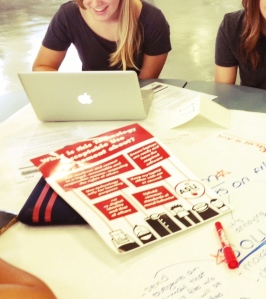ORIENTATION DAY 2012
A student-led discovery of our high school’s Acceptable Use of Technology Agreement
After liberating Orientation Day, Glenda and Ritu re-imagined it as a discovery-based learning environment that would foster engagement, through peer interaction and group work, around the complex issues of our Acceptable Use of Technology Agreement (AUA). The activity they jump-started involved the formation of self-selected groups. Each group was given a different problem scenario involving one of the elements of the AUA. All of the scenarios were authentic ethical conundrums from the previous year school year. In forty minutes, each group had to:
- determine how their problem ran up against AUA,
- generate practical solutions to bring to bear on their problem scenario, and
- decide on the best way to present their findings to the rest of the group.
After 40 minutes of intense collaborative work, six groups — representing each of the AUA elements — were asked to come forward and present to the entire group.
The outcomes were wonderfully varied:
- power point presentations with quickly grabbed iPhone images
- original art posters
- quickly scripted and rehearsed raps and skits.
The messages, conceived and delivered by students, were clear, powerful, quirky and fun. Everyone paid attention. AUA got its due.
So, why FEARLESS?
I used the word fearless to describe this learning event because both the teacher facilitators and the students exemplified courage.
As the facilitators, Glenda and Ritu fearlessly gave up total control over content and outcome. They let go:
- of the common numbing notion that they had a certain set amount of sacred material to pass on in a finite period of time….
- and that evidence of its uptake had to have a prescribed look.
Instead, they asked students to access what they already knew about ethical behavior, their “prior knowledge”, and to apply it to potential situations they might encounter in high school (Booth, 2011, p. 44, 57-58). They put their faith in the idea that an outcome crafted by the students themselves would have more meaning and transformative power than a load of teacher-delivered instruction. They believed that, if the AUA is truly important in our school, orientation day is not the sole point of delivery for the lessons of AUA. It will be woven and reinforced throughout the school year in other settings, by other teachers and by the students themselves.
Students fearlessly tackled a rather open-ended problem with no set roadmap. The first ten minutes, after the groups were set to their task, there was a palpable discomfort in the room. Students were disoriented and unsure, unaccustomed to being left so free to construct their own learning. But, almost to a group, they quickly rose to the challenge. They knuckled down, brainstormed, asked clarifying questions, kicked around different ideas, rehearsed and swiftly applied various literacies to polish a product. They put themselves out in front of their peers as creators, presenters and problem solvers.
It was just so cool. You should have been there!
Why did it feel so right? Char Booth (2011) explains the theory and best practices that run deep within Glenda and Ritu’s refashioning of how our students experienced Orientation Day and what, in the end, they took away as useful, transformative knowledge. Glenda and Ritu conceived a successful blend of direct and discovery strategies and tinkered with Booth’s four factors of learning – motivation, memory, prior knowledge, and environment — to create a learning experience that maximized engagement and, with that, hopefully transfer and recall (Booth, 2011, p. 43-45, 52-54).
With Glenda and Ritu’s reflective practice, our orientation day has transformed from a blur of disconnected tasks to a cohesive whole that has students ready to learn in every sense of the word.
Reference:
Booth, C. (2011). Reflective teaching, effective learning: Instructional literacy for library educators. Chicago, IL: American Library Association.


Wow, Ruth. What an exciting transformation in your orientation “program”. This is really exciting! I especially love the element of peer-to-peer presentation. What a great way to build in extrinsic motivation!
Thanks for your comment, Pam! It was really fun to watch each group rapidly compose a presentation. In most groups, it was a choppy start at first and then… boom!…sort of an instant coalescing around the group’s skill set and desire to get it done. There were a few groups that were disorganized or “not into it”. They were interesting to observe too.
Another fun observation was the reaction of some of our peer helpers. Peer helpers were returning high school students who were enlisted to help out by going from group to group to answer questions and provide direction. Some of those student helpers were really miffed by groups that were, in their opinion, off-task. Several….kinda fresh out of 9th grade themselves….expressed shock at the goofiness of incoming 9th graders. Funny what wearing a different hat will do for one’s perspective.
Wowza – what an incredible examination of transformational learning! I love the bit about Glenda and Ritu giving up control. You outline a success story others can learn from and adapt.